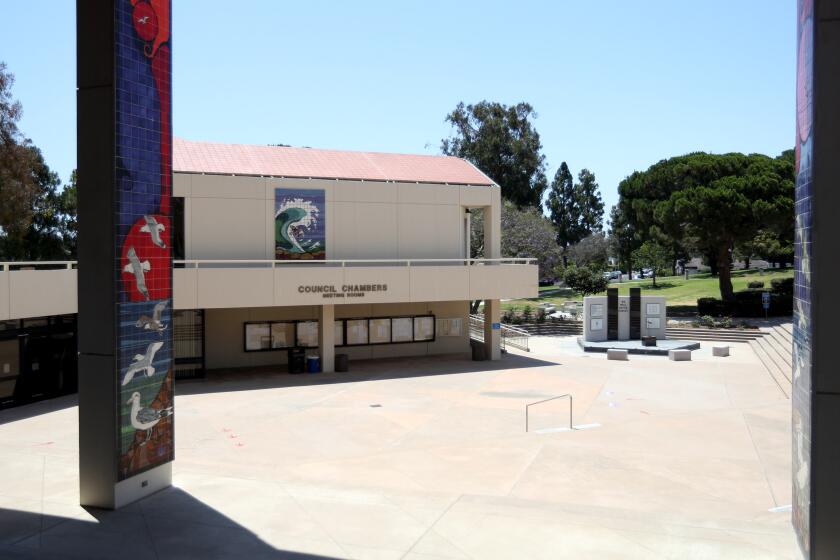Low voter turnout the real culprit
- Share via
There is quite a bit of debate going on in Costa Mesa (and
probably parts of Newport Beach) about last week’s City Council
election results. A leading theory about how Mayor Linda Dixon lost
to newcomer Allan Mansoor holds that Dixon and Planning Commission
Chairwoman Katrina Foley split votes. (The theory was mentioned in
this column last week.)
Mansoor got elected with 7,498, not too far ahead of Dixon’s
6,996. Foley trailed at 5,613. The thinking is that, obviously,
without Foley in the race, Dixon would have received a bulk of that
vote, raising her to a winning total.
It is a pat, easy theory, one that lays blame at the feet of the
two women in the race. There is a tinge of misogyny in the idea that
voters will not punch the ballot for two women, a perspective that
ought to be examined as the discussion about how and why continues.
The theory doesn’t seem to hold up when the numbers are
scrutinized. Those numbers, when compared to the election two years
ago, are stark and surprising and suggest that forces that played out
in 2000 were active again last Tuesday.
Those forces are the position Mansoor had on the ballot and the
practice of some of his supporters to “bullet vote.”
Turning back to 2000, there were 11 candidates running for three
seats. Chris Steel was the top vote-getter, with 10,664, followed by
Libby Cowan (then an incumbent) with 10,276 and finally Karen
Robinson with 9,224 (scant votes ahead of then-incumbent Heather
Somers, who trailed with 9,192).
Steel, like Mansoor, was at the top of the ballot and had the
support of Westside activists who voted solely for Steel (“bullet
voting”). The number of candidates, coupled with Steel’s choice
ballot position and the name recognition he’d earned through all his
earlier runs, dovetailed for his victory.
This year, with just five people running for two seats, it did not
appear heading into the election that Mansoor could count on the same
combination of forces. With the Westside bullet voters amounting to
somewhere between 700 and 1,000 persons, according to different
estimates, their numbers would have had less of an effect on the
outcome. Mansoor could not count on the “blind” top of the ballot
votes to make as much of a difference, either.
But check these two numbers: 34,187 and 108,076. Those are the
total votes for City Council candidates in 2002 and 2000,
respectively. Not accounting for “bullet voters,” they mean that
about 17,000 people voted this year, compared to 32,000 in 2000.
Low voter turnout, it turns out, evened the playing field.
It seems doubtful that, had 30,000 or so voters gone to the polls
last week, Mansoor’s numbers -- bumped up 800 bullet voters, perhaps
-- would still have topped Dixon’s (the difference between them, as
it was, was just 502, well within this bullet-voting margin).
There is also this trend to consider. While Republicans did not
sweep through California the way they did the rest of the nation, the
general consensus among political pundits is that Republicans went to
the polls in far greater, and more enthusiastic, numbers than did
Democrats. Given that both Dixon and Foley are Democrats and Mansoor
appeared on many Republican slate mailers, it’s reasonable to assume
that those missing voters would have backed one of the two women.
(As an explanatory digression, yes, council races are nonpartisan.
But the policies Foley and Dixon were pressing, including strategic
plans and emphasis on the arts, vs. Mansoor’s policies would play to
Democrats rather than Republicans.)
So, the real story of this year’s election might be who did not
vote.
Regardless, probably the only sure result of this election is that
the leading vote-getter, Gary Monahan, had close to a mandate of
support by drawing 31% of the vote, even though his 10,597 were fewer
than Steel’s votes in 2000.
The principle of the matter
As a quick bit of self-promotion, on Saturday -- through what can
only be a matter of no one else being available -- I’ll be talking at
Gil Ferguson’s Principles over Politics monthly breakfast.
I’ll be playing the part of an expert on Newport-Mesa politics.
Feel free to sleep in, if you want. I am looking forward to it,
though.
* S.J. CAHN is the managing editor. He can be reached at (949)
574-4233 or by e-mail at steven.cahn@latimes.com.
All the latest on Orange County from Orange County.
Get our free TimesOC newsletter.
You may occasionally receive promotional content from the Daily Pilot.







